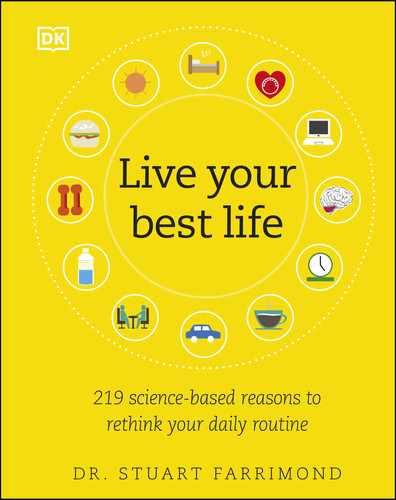g CONTENTS
Data credits
The publisher would like to thank the following for their kind permission to reproduce their data:
D. Bruck & D.L. Pisani, “The effects of sleep inertia on decision-making performance”, J Sleep Res, 1999, 8(2):95–103.
doi:10.1046/j.1365-2869.1999.00150.x.
P. Tassi & A. Muzet, “Sleep inertia”, Sleep Med Rev, 2000, 4(4):341–353.
doi:10.1053/smrv.2000.0098.
M. Terman & J. Terman, “Light Therapy for Seasonal and Nonseasonal Depression: Efficacy, Protocol, Safety, and Side Effects”, CNS Spectrums, 2005, 10(8):647–663.
doi:10.1017/S1092852900019611, reproduced with permission.
B.C. Koch et al., “Circadian sleep-wake rhythm disturbances in end-stage renal disease”, Nat Rev Nephrol, 2009, 5(7):407–16.
doi:10.1038/nrneph.2009.8.
(melatonin and cortisol data).
Copyright 2004 National Sleep Foundation – www.sleepfoundation.org.
Adapted from: G. Zerbini & M. Merrow, “Time to learn: How chronotype impacts education”, Psych J, 2017, 6(4):263–276.
doi:10.1002/pchj.178.
T. Walsh et al., “Fluoride toothpastes of different concentrations for preventing dental caries”, Cochrane Database of Systematic Reviews, 2019, Issue 3, Art. No.: CD007868.
doi:10.1002/14651858.CD007868.pub3.
H. Isaksson et al., “High-fiber rye diet increases ileal excretion of energy and macronutrients compared with low-fiber wheat diet independent of meal frequency in ileostomy subjects”, Food Nutr Res, 2013, 57(1).
E.E. Helander et al., “Weight Gain over the Holidays in Three Countries”, N Engl J Med, 2016, 375(12):1200–1202.
doi:10.1056/NEJMc1602012.
B. Clark et al. (CTS, Department of Geography and Environmental Management, UWE, Bristol), “How commuting affects subjective wellbeing”, Transportation, 2019, 1–29.
Adapted from: P. Parthasarathi et al., “Network Structure and Travel Time Perception”, PLoS ONE, 2013, 8(10):e77718.
doi:10.1371/journal.pone.0077718
L. Nummenmaa et al., “Bodily maps of emotions”, Proc Natl Acad Sci USA, 2014, 111(2):646-651.
doi:10.1073/pnas.1321664111.
Adapted from: S.J. Ritchie et al., “Sex Differences in the Adult Human Brain: Evidence from 5216 UK Biobank Participants”, Cereb Cortex, 2018, 28(8):2959–2975.
doi:10.1093/cercor/bhy109.
M.M. Perrigue et al., “Higher Eating Frequency Does Not Decrease Appetite in Healthy Adults”, J Nutr, 2016, 146(1):59–64.
doi:10.3945/jn.115.216978.
C.R. Mahoney et al., “The Acute Effects of Meals on Cognitive Performance” in HR Lieberman et al., “Nutrition, brain, and behaviour”, Nutr Neurosci, 2005, 73–91.
doi:10.1201/9780203564554.ch6.
WHO, “WHO calls on countries to reduce sugars intake among adults and children”, press release, 2015, who.int/mediacentre/news/releases/2015/sugar-guideline/en/, accessed Jun 2020.
Adapted from: D.R. Reed & A.H. McDaniel, “The human sweet tooth”, BMC Oral Health, 2006, 6(1):S17.
doi:10.1186/1472-6831-6-S1-S17.
A. Dijksterhuis et al., “On Making the Right Choice: The Deliberation-Without-Attention Effect”, Science, 2006, 311(5763):1005–1007.
doi:10.1126/science.1121629.
C.M. Alberini & A. Travaglia (Society for Neuroscience), “Infantile Amnesia: A Critical Period of Learning to Learn and Remember”, J Neurosci, 2017, 37(24):5783–5795.
doi:10.1523/JNEUROSCI.0324-17.2017.
J.K. Hartshorne & L.T. Germine, “When does cognitive functioning peak? The asynchronous rise and fall of different cognitive abilities across the life span”, Psychol Sci, 2015, 26(4):433–443.
doi:10.1177/0956797614567339.
L. Cipryan et al., “Acute and Post-Exercise Physiological Responses to High-Intensity Interval Training in Endurance and Sprint Athletes”, J Sports Sci Med, 2017, 16(2):219–229.
D.H. Wasserman, “Four grams of glucose”, Am J Physiol Endocrinol Metab, 2009, 296(1):E11-E21.
doi:10.1152/ajpendo.90563.2008, fig.2.
A. Puce et al., “Neural Bases for Social Attention in Healthy Humans”, in The Development of Social Attention in Human Infants, 2015, pp93–127.
doi:10.1007/978-3-319-21368-2_4,fig.4.1.
S. Brinkhues et al., “Socially isolated individuals are more prone to have newly diagnosed and prevalent type 2 diabetes mellitus: The Maastricht study”, BMC Public Health, 2017, 17(955).
doi:10.1186/s12889-017-4948-6.
C. Wyart et al., “Smelling a Single Component of Male Sweat Alters Levels of Cortisol in Women”, J Neurosci, 2007, 27(6):1261-1265.
doi:10.1523/JNEUROSCI.4430-06.2007. Copyright 2007 Society for Neuroscience.
A. Weiss et al., “Midlife crisis in great apes, PNAS, 2012, 109(49):19949–19952.
doi:10.1073/pnas.1212592109.
J.K. MacCormack & K.A. Lindquist, “Feeling hangry? When hunger is conceptualized as emotion”, Emotion, 2019, 19(2):301–319.
doi:10.1037/emo0000422.
CDC.
Adapted from: L. Castaldo et al., “Red Wine Consumption and Cardiovascular Health”, Molecules, 2019, 24:3626.
K. Middleton Fillmore et al., “Moderate alcohol use and reduced mortality risk: Systematic error in prospective studies”, Addict Res Theory, 2006, 14(2):101–132.
doi:10.1080/16066350500497983.
Adapted from: B.J. Brown et al., “A Neural Basis for Contagious Yawning”, Curr Biol, 2017, 27(17):2713–2717.e2.
doi:10.1016/j.cub.2017.07.062.
A.G. Guggisberg et al., “Why do we yawn? The importance of evidence for specific yawn-induced effects”, Neurosci Biobehav Rev, 2011, 35(5):1302–1304.
doi:10.1016/j.neubiorev.2010.03.008.
K.J. Brower, “Alcohol’s effects on sleep in alcoholics”, Alcohol Res Health, 2001, 25(2):110–125.
T. Roehrs & T. Roth, “Sleep, sleepiness, and alcohol use”, Alcohol Res Health, 2001, 25(2):101–109.
C.J. Wild et al., “Dissociable effects of self-reported daily sleep duration on high-level cognitive abilities”, Sleep, 2018, 41(12):zsy182.
doi:10.1093/sleep/zsy182, fig.3.
Copyright 2004 National Sleep Foundation – www.sleepfoundation.org.
To access the complete list of source materials, studies, and research supporting the text in this book, visit:
